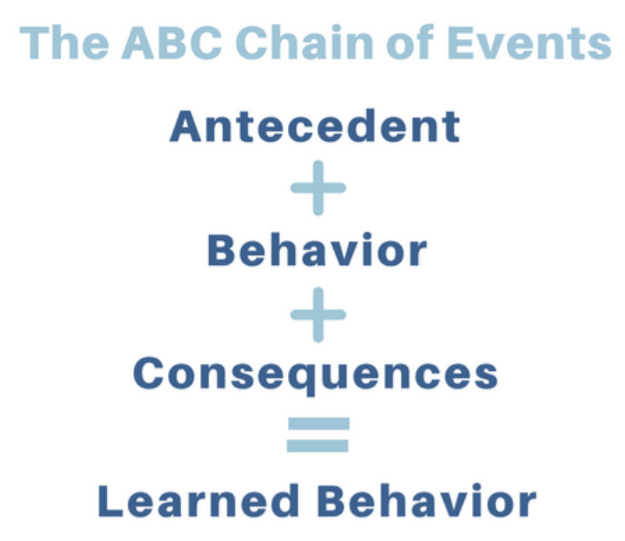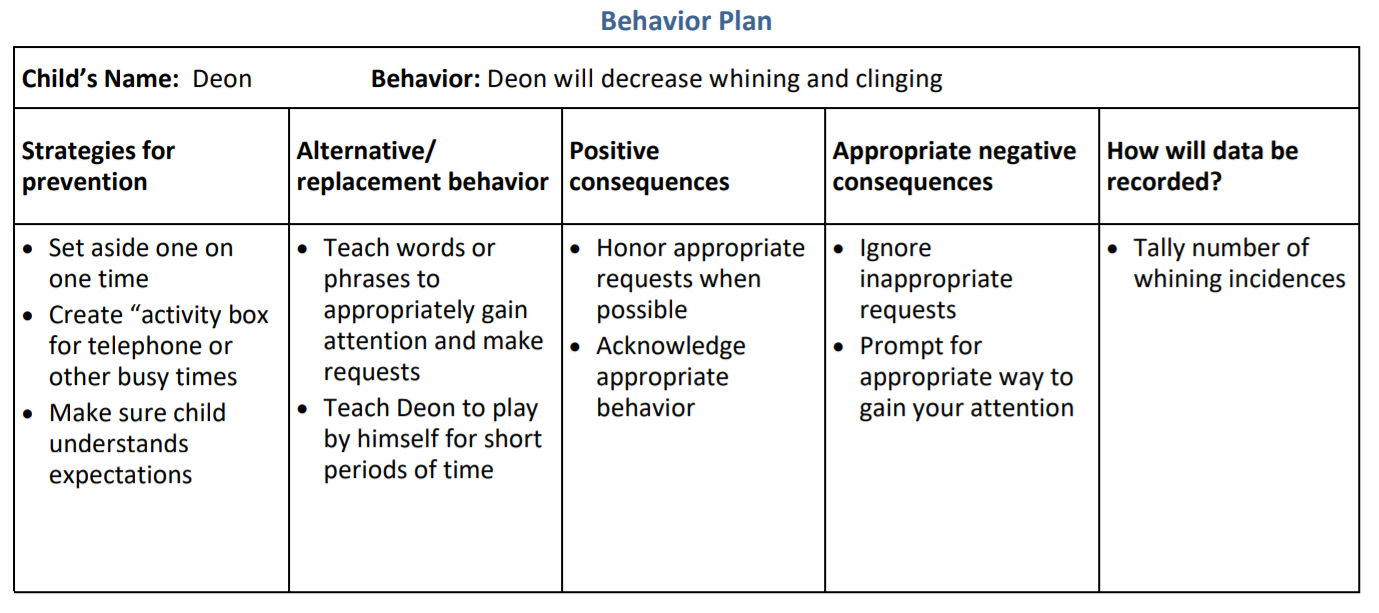Printable PDF
The ABC’s of Challenging Behavior
Behavior problems involve any challenging behavior that lasts over time and is working for the child, meaning bringing the results he or she wants. This takes the form of a child not doing what is wanted, or doing something that isn’t wanted by adults. Before we can address a challenging behavior, we need to be able to identify and define the problem clearly.
This way, parents, teachers and caregivers can recognize the behavior. The behavior needs to be observable and measurable. It could be measured by how long it lasts, the number of times it happens, or even the intensity of the behavior. If I say that my child, Susie “tantrums and cries all the time,” I am not being very specific and am not giving any way to measure the behavior. If, instead, I say “Susie tantrums longer than 15 minutes three times each day, and her tantrums involve crying loudly, lying on the floor and kicking,” I’ve defined the behavior specifically and in a way that can be measured. From this description, caregivers and I know what the behavior looks like (for example, whining and tugging my shirt is not the same as a tantrum), and whether Susie is having a better or worse day than usual (frequency and duration).

The next step is to figure out what is causing the behavior. Could it be…
- health related?
- due to a lack of communication skills?
- because of a major life change, such as a new baby sibling, moving to a new home?
Or, is the behavior explained by my child’s stage of development? In other words, is she doing what other children typically do at this age? Parents can consult developmental checklists to find this out (See the Related Resources section). If so, is there a way to limit the behavior to a specific time or place or for a specific amount of time?
Consequences are very important, because they either encourage or discourage the behavior. When positive things happen to or for the child as a result of the behavior, the behavior is rewarded, and the behavior will increase. When unpleasant things happen to or for the child as a result of the behavior, the behavior will happen less often.
What do behaviors do for us? What are some functions of behavior?
- Acknowledgement/attention
- Escape/avoidance
- Sensory/automatic
For example, Billy interrupts me when I’m on the telephone because he wants my attention. Sally throws a fit when I tell her it’s time to clean her room to avoid doing so. Isaac tears up his homework because he likes the sound of the paper tearing. We want to write an Action Plan to stop the unwanted behavior. However, it isn’t enough to just stop the unwanted behavior – we need the child to learn an alternative or replacement behavior. This new behavior should fulfill the same function as the problem behavior (in this case, get attention from Mom) and be just as easy for the child to do.
Why isn’t it enough to just stop the unwanted behavior? Because this won’t address the reason the child started the behavior. If we only say “stop it” to the child interrupting us while we’re on the phone, she may just switch to a new behavior that will work for her in the same way (such as pushing over glasses of water while I’m on the phone.). The new behavior may even be worse and less socially acceptable than the initial behavior. Also, our response (covering the phone and yelling “Stop!”) may unintentionally reinforce and strengthen the misbehavior (“Hmm, Mom noticed me”).
When it comes to helping children with challenging behaviors, it helps to remember that behavior can be changed over time and that the best strategy is the one that works. Evaluate how well the strategy is working regularly, and adapt the plan as your child changes.
To increase a desired behavior, choose consequences that are positive and pleasant. Discover what is motivating to your child. Try to use the smallest amount necessary to get the change you want. Positive consequences/reinforcement are most effective when they are:
- Immediate
- Consistent
- Specific
- Sincere
- Varied before the child tires of the particular reinforcement
- Fair, start with small changes.
To decrease a problem behavior, figure out why it is happening.
- Is it because she wants to gain something – toy, food, activity, your attention?
- Is it because he wants to avoid doing as you have asked, or to get away from a situation or something he doesn’t like? If the behavior is to get attention, try these solutions:
- Increase attention for the child’s positive behaviors
- Teach acceptable alternative
- Reinforce when the child gains attention through appropriate behavior
- Withhold attention for problem behaviors
- Only use time-out as a last resort
- Avoid lecturing, scolding. If the child is trying to gain something (an object, activity, food), try these solutions:
- Do not give the object to the child following problem behavior
- Teach acceptable ways to get the object
- Give the object to the child following appropriate behavior
- Use time-out only as a last resort
If the behavior is to escape or avoid a situation, try these solutions:
- Reward for following directions
- Teach how to communicate wants and needs appropriately,
- Do not remove the request following problem behavior
- Do not use time-out
You can measure the results by tracking your child’s behavior by the hour, by the day or by the week. You can use a tally chart or an “ABC” chart for problem behavior, and be sure to observe the alternative or replacement behavior your child is using.
In selecting a replacement behavior to teach, think about what it is you would like to see the child do instead. The replacement behavior is a new skill that needs to be taught and practiced. Use small steps and celebrate small progress. Modeling and role playing can be effective ways to teach new skills. Now that you have a Behavior Plan for your child, try it out. Follow it as you have written it, record your observations. Don’t be discouraged if the misbehavior increases at first. It is common to see this before the behavior begins to improve. Remember to be consistent!
Follow up and evaluate how your plan has worked. Remember to record your information and then compare it to your original information. For example, how does this week compare to last week? If your child’s behavior is improving, continue to reinforce it. Remember to change the rewards as needed before your child tires of them. Over time, gradually reduce the use of the rewards. If the problem behavior continues, you can always try another solution, you can work with other families to see what has worked for them, and you can contact ASK Resource Center or your Family Educator Partner at the AEA in your area.
Examples of the ABC chart and Behavior Plan mentioned above can be found below.
Related Resources:
ASK Essential Questions
- What does the data tell me about my child’s behavior?
- What is the behavior providing my child?
- What skills can I teach my child to replace the challenging behavior?

